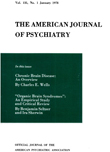METHODOLOGY IN SHORT-TERM THERAPY
Abstract
Short-term therapy has more than utilitarian value. There are indications that it will, as its methodology becomes elaborated, develop into the treatment of choice for a considerable number of patients. This conviction is supported by observations from a variety of sources to the effect that patients suffering from a wide spectrum of emotional problems, treated over a short period of time, may obtain not only sustained relief, but also, in some cases, personality changes of a reconstructive nature that would have been considered significant had long-term treatment been employed. Four stages in the course of short-term therapy seem apparent: 1) a supportive phase during which homeostasis is brought about through the healing influences of the relationship with the therapist, the placebo effect of the therapeutic process, and the decompressive impact of emotional catharsis; 2) an apperceptive phase, characterized by the ability to understand, even minimally, the meaning of the complaint factor in terms of some of the operative conflicts and basic personality needs and defenses; 3) an action phase distinguished by a challenging of certain habitual neurotic patterns, facing them from a somewhat different perspective and 4) an integrative relearning and reconditioning phase which continues after termination on the basis of the chain reaction started during the brief treatment period.
The specific techniques that are outlined in the paper are contingent, first, on the acceptance of eclecticism, adopting procedures from every field of psychiatry, psychology, sociology, education and even philosophy, that may be of help in the total treatment effort; second, on the existence of flexibility in the therapist that enables him to adjust his stratagems to the immediate needs of the patient and therapeutic situation; and third, on the studied employment of activity in the relationship. All modalities are employed in those combinations that may be of value, including psychoanalytic techniques, interviewing procedures, drugs, hypnosis, reconditioning and group therapy.
Among the procedures that may expedite treatment are the following: 1) establishing a rapid working relationship (rapport); 2) circumscribing the problem area as a focus for exploration; 3) evolving with the patient a working hypothesis of the psychodynamics of his difficulty; 4) employing dream interpretation where the therapist is analytically trained; 5) alerting oneself to resistances and resolving these as rapidly as possible; 6) dealing with target symptoms like excessive tension, anxiety and depression, through the careful use of drugs; phobic phenomena by conditioning techniques; obsessive-compulsive manifestations by persuasive tactics, etc.; 7) teaching the patient how to employ insight as a corrective force; 8) outlining with the patient a definite plan of action by which he can use his understanding in the direction of change; 9) searching for transference elements and resolving these quickly before they build up to destroy the relationship; 10) encouraging the development of a proper life philosophy.
Access content
To read the fulltext, please use one of the options below to sign in or purchase access.- Personal login
- Institutional Login
- Sign in via OpenAthens
- Register for access
-
Please login/register if you wish to pair your device and check access availability.
Not a subscriber?
PsychiatryOnline subscription options offer access to the DSM-5 library, books, journals, CME, and patient resources. This all-in-one virtual library provides psychiatrists and mental health professionals with key resources for diagnosis, treatment, research, and professional development.
Need more help? PsychiatryOnline Customer Service may be reached by emailing [email protected] or by calling 800-368-5777 (in the U.S.) or 703-907-7322 (outside the U.S.).



